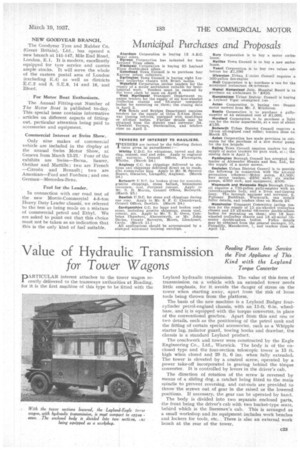Value of Hydraulic Transmission
Page 73

If you've noticed an error in this article please click here to report it so we can fix it.
for Tower Wagons Reading Places Into Service the First Appliance of This Kind with the Leyland Torque Converter PARTICULAR interest attaches to the tower wagon recently delivered to the tramways authorities at Reading, for it is the first machine of this type to be fitted with the
Leyland hydraulic tran,smission. The value of this form of transmission on a vehicle -with an extended tower needs little emphasis, for it avoids the danger of stress on the tower when starting away, apart from the risk of loose tools being thrown from the platform.
The basis of the new machine is a Leyland Badger fourcylinder petrol-engined chassis, with an 11-ft. 6-in, wheelbase, and it is equipped with the torque converter, in place of the conventional gearbox. Apart from this and one or two details, such as the positioning of the petrol tank and the fitting of certain special accessories, such as a Whipple starter lug, 'radiator guard, towing hooks and drawbar, the chassis is a standard Leyland product.
The coachwork and tower were constructed by the Eagle Engineering Co., Ltd., Warwick. The body is of the enclosed type and the four-section telescopic tower is 13 ft. high when closed and 29 ft. 6 ins, when fully extended. The tower is elevated by a control screw, operated by a power take-off incorporated in gearing behind the torque converter. It is controlled by levers in the driver's cab.
The direction of rotation of the screw is reversed by means of a sliding dog, a ratchet being fitted to the main spindle to prevent reversing, and cut-outs are provided to throw the screws out of gear in the raised or the lowered positions. If necessary, the gear can be operated by hand.
The body is divided into two separate enclosed parts, the front being the driver's cab with two bucket-type seats, behind which is the linesman's cab. This is arranged as a small workshop and its equipment includes work benches and lockers for tools, etc. . There is also an external work bench at the rear of the tower.
























































































































































